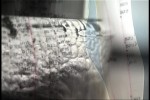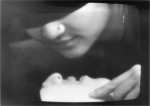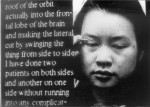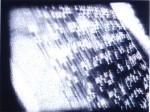Epilogue: The Palpable Invisibility of Life (DV; 14m; 2006)
Producer, Director, Writer, Camera, Sound, Editor
This is the final tape in the Blindness Series, a body of eight videos on blindness and its metaphors that was begun in 1992. The inspiration for the series came from a 1990 exhibition Jacques Derrida curated for the Louvre Museum, titled Memoirs of the Blind. When Derrida died in 2004, Epilogue shifted focus from his work on mourning to ruminate on 1) the visible and invisible traces one leaves behind: a font made from Derrida’s infamous handwriting, my mother’s dying words, etc.; 2) the cycle of life and death: my son’s birth on the same day, date, and time as my mother’s death six years prior; and 3) imaging technologies that allowed me to see my unborn son, leading to fantasies about what technologies it would take to “image” my incorporeal mother, and discovering that ancient medicine brings me closer to my dead mother.
Producer, Director, Writer, Camera, Sound, Editor
A portrait of Nguyen Duc Dat, a blind guitarist who is a “triple outcast”: disabled, Amerasian, and an orphan. Dat went from a life on the streets of Saigon selling lottery tickets to winning guitar championships in the state of California, where he now resides. The video unfolds in layers of conversation with Dat about his experiences as a new immigrant and young adult in America.
Producer, Director, Writer, Camera, Sound, Editor, Voice
An experimental video about word-blindness and metaphor. Word-blindness (alexia) is a condition that usually afflicts people who have suffered a stroke, causing them to lose the visual recognition of individual letters but perceive the entire word, or vice versa. Metaphors are here discussed in their function to reveal and obscure perception. Divided into five short sections, the tape draws a pattern with several motifs—the finger (pointing as one of the earliest forms of language), the moon (contrasting Buddhist and Wittgensteinian philosophies about metaphors and the visible)—to ruminate on language and blindness. Giambattista Vico’s theory on the origin of language is also addressed.
ekleipsis (Betacam; 22m; 1998)
Producer, Director, Writer, Camera, Sound, Editor, Voice
An experimental documentary about a group of Cambodian women in Long Beach, California, known as the largest group of hysterically blind people in the world. Hysterical blindness is a psychological condition where one is not able to see despite the absence of physical problems. ekleipsis traces two histories: the Cambodian Civil War and hysteria, to speak about pathology and agency. To transcend what has been described as the ‘eye-searing’ horrors of war, these women cried themselves into blindness.
Producer, Director, Writer, Camera, Sound, Editor, Talent
An experimental video addressing issues of surveillance and technology that allow us to see where we normally can not. Through a 1-800 (toll free) phone number publicized nationally, recorded messages of fears and fantasies about video surveillance were collected from callers: If you were caught on videotape, what would be the worst thing you could be caught doing? If you could watch someone, what would you want to see? The video highlights several narratives to raise issues of surveillance: the construction of our society’s desire to watch surveillance materials and its insatiable voyeurism, as well as what it would mean to have an alter-electronic ego or to be biologically tagged without the recourse to ‘pass’ for survival’s sake.
Producer, Director, Writer, Camera, Sound, Editor, Voice
kore is a project which investigates the conjunction of sexuality with 1) the eye as purveyor of desire; 2) the sexual fear and fantasy of blindness and the blindfold; and 3) women and AIDS. Can the blindfold embody a touch-based pleasure associated with female sexuality, in contrast with a vision-based pleasure assigned to male sexuality? Could the choice to not-see facilitate ecstasy for the subject? How does fear and fantasy contrast with the reality of vision loss in advance stages of AIDS?
Producer, Director, Writer, Sound, Editor, Talent
This experimental documentary juxtaposes footage from visits with seven cosmetic surgeons specializing in blepharoplasty (eyelid surgery) within the Beverly Hills/West Hollywood area with text describing a 1950’s lobotomy procedure to treat psychological patients. This juxtaposition comments on cosmetic surgery as a ‘desperate cure’. Cosmetic surgery of the eyelids on Asian women is regarded as a self-effacing fantasy of attaining the standard of beauty, a standard which demands conformity to the norm of being average. The artist poses as a potential patient while consulting with the seven cosmetic surgeons.
Producer, Director, Writer, Camera, Sound, Editor, Voice
As the introduction to the series, this video provides an index of topics on different aspects of physical blindness and its metaphors. Multiple modes of discourse are employed: journalistic, anecdotal, fictive, and theoretical to bring out various perspectives on the issues addressed. aletheia experiments with non-linear structure to spur associative viewing amongst the seemingly disparate ideas; this structure is also a formal reflection of our perceptual process.







